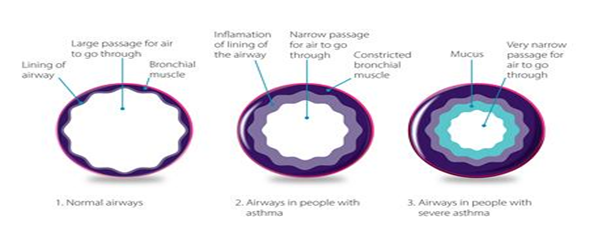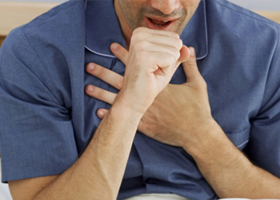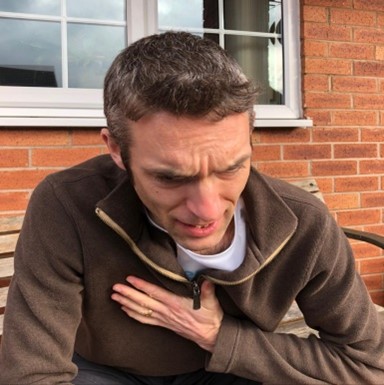Conditions Treated
What conditions are treated and what are the benefits?
The conditions that Chest Just Physio treats are: -
- Long Covid
- COPD
- CF
- Asthma
- Bronchiectasis
- Hyperventilation
- recovering from pneumonia or a lingering chest infection
Sorry I don't treat any neck, back, and arm or leg problems.
Chest physiotherapy could benefit you if you cough up secretions / phlegm on a regular basis, by teaching you clearance techniques which may help you clear your chest more effectively. This could lead to:-
- Improved sleep, due to a reduction in overnight coughing,
- Reduced number of chest infections, due to better self-management of your chest problem.
- Reduced breathlessness, by teaching pacing and better management of any secretions / phlegm
- Reduced embarrassment of coughing up secretions / phlegm in front of people.
- Increased self-control of your chest problem, by increasing your understanding of your condition and the medication you may be taking.
If you have been told by your Doctor that you Hyperventilate (over breathing) Chest physio could benefit you by teaching you techniques which may help you to reduce / get rid of some of your symptoms.
The Basics of Breathing!
To have an understanding of a lung condition, you need first to have a basic understanding of what makes up your lungs and how they work.
Imagine your lungs are like an upside down tree; the tree trunk is your windpipe (trachea), it then splits into two main branches, your left and right lung, which then in turn divide into smaller branches (bronchial). Finally these split into even smaller branches (bronchioles), and then into the 'small twigs', your alveoli (small air sacs).
Air is carried in and out of your lungs by a series of branches (bronchial). These branches have small glands in them which produce mucus. This sticky liquid helps to keep the airways moist and traps any airborne dust and germs, which we inhale all the time.

Picture from British Lung Foundation
When the bronchial become damaged due to infection, illness or smoking they are unable to clean themselves properly. The mucus starts to build up and eventually spills out into the airways. This clogs them up making it harder to breath and leads to an increased chance of picking up an infection.
A Brief Explanation of Different Lung Conditions
Bronchitis
The word 'itis' simply means inflammation, therefore Bronchitis is an inflammation or swelling of the lining of the bronchial.
The inflammation causes increase production of the mucus that lines the airways, thereby clogs up the airways with thick phlegm and making it more difficult to breathe
Long Covid
1 in 20 people who have had covid will suffer with covid symptoms that last longer than eight weeks (covid symptoms study 2020). The reason why some people get long covid is unknown, as it does not seem to relate to the severity of the symptoms when the person had covid. However currently it seems to affect women more than men.
Everyone’s recovery from covid is different. The pattern and severity of symptoms can range from shortness of breath, fatigue, pains, sleep problems, headaches, stomach issues and many other symptoms which can fluctuate and change over time. It can be quite difficult to come to terms with the impact it is having on your body and mind.
COPD (Chronic Obstructive Pulmonary Disease)
This is an umbrella term to describe a number of lung conditions, such as chronic bronchitis and emphysema, where people have difficulty breathing due to long term damage to their lungs.
Chronic meaning a long term problem
Obstructive meaning narrowing of the airways caused by damage done to them. The most common trigger is smoking, thereby making it much more difficult to get air in and out of the lungs.
Pulmonary meaning affecting the lungs
Disease meaning incorrect functioning of that part of the body
Emphysema - where the air sacs (alveoli) in the lungs lose their elasticity (springiness). This affects the support of the airways causing them to narrow, therefore leading to the lungs becoming less effective in getting oxygen into the body. As a result it becomes harder to breath and this causing breathlessness.
Chronic Bronchitis - inflammation of bronchial (airways) which causes increased mucus production in the airways. This leads to production of phlegm which gives rise to a cough.
Bronchiectasis
When the bronchial get damaged they become unable to clean themselves. Mucus (phlegm) builds up which then spills out into the airways, raising the likelihood of infection. This causes inflammation which leads to bronchial damage.
There are several known causes of Bronchiectasis:-
- Blockage caused by scarring: - When any part of your body heals it can leave a scar behind, and it is the same in the lungs. This can happen from repeated chest infections, childhood infections such as measles, whooping cough or pneumonia.
- Inhaling a foreign object, for example a peanut, which causes inflammation and damage to the airways
- Underlying genetic problem, for example cystic fibrosis (CF), where the bronchial are too thick or not working properly.
- However in over half of people with bronchiectasis there is no apparent cause
Cystic Fibrosis (CF)
CF is a genetic condition caused by a faulty gene. This gene controls the movement of salt and water in and out of the cells in the body. As a result the lungs and digestive system get clogged up with thick sticky mucus, which makes it harder to breathe and digest food
Asthma
Asthmatics have 'over sensitive' or 'hyper reactive' airways, meaning the bronchial which carry air in and out the lungs get irritated. This causes the airways to become inflamed, swollen and narrowed. The bronchial muscles go into spasm leading to the airways narrowing and it becoming harder to get air in and out the lungs. As the airways become more inflamed, more mucus than normal is produced which narrows the airways even further
Changes that occur in asthmatic airways

Picture from British Lung Foundation
Hyperventilation Syndrome (HVS)
This is also called 'Dysfunctional breathing' or 'over-breathing'
This disorder is caused by a person breathing too deeply or too quickly, which could be caused by a physical or physiological problem.
Breathing too fast can cause dizziness, light-headedness, weakness, breathlessness, a sense of unsteadiness, a tingling feeling around the mouth or fingertips, chest pains or panic attacks. People with HVS often feel that they cannot get enough air in, when in fact they can. However what actually happens when over-breathing is that you breathe out too much carbon dioxide, which affects oxygen getting around the body that may cause many different symptoms.
Hyperventilating is often a self-perpetuating problem. During over-breathing the carbon dioxide levels fall below normal levels, which causes worsening symptoms and causes the person to breathe even faster.
Before considering Chest Physio, please have your doctor examine you to check that your symptoms are not being caused by an underlying problem. Many of the symptoms can be experienced with other conditions.
However you may have had a multitude of investigations for your symptoms, only to be told that you are 'hyperventilating' 'over breathing' or have 'dysfunctional breathing'. This may make you feel rather 'fobbed off' or that you are not being taken seriously. The symptoms that you are experiencing are real and not in your head, however they may be being caused by an imbalance in your body rather than anything more serious.
How Can Chest Physio Help me?
With my chesty cough and phlegm problem?
As explained in 'Basics of Breathing' section, our airways are lined with mucus which helps to clean out any airborne dust or germs that we may inhale. People with chest problems often produce more mucus (phlegm); this makes them more likely to get chest infections and experience breathing difficulties, as the germs we breathe in are more likely to grow and multiply.
To help you understand the importance of doing regular chest physio, think of a bucket of water. If left outside for long enough it will become stagnant with something. The same happens with mucus (phlegm) in your chest. If there are 'pockets' of mucus not moving in your chest , it provides a lovely warm wet environment for inhaled germs to start growing and multiplying, leading to a chest infection. However with regular chest physio clearing and moving the mucus on your chest, it makes it harder for germs to grow and take hold.
Physio can help with managing your secretions (phlegm) by teaching you breathing exercises to help you cough up and clear any secretion off your chest. Techniques used will be explained further in 'Chest Physio treatments' section.
With my breathlessness?
People with breathing problems often 'fear' breathlessness, but often forget breathing faster and deeper is a normal response to doing exercise/ physical activity. Everyone gets breathless when undertaking physical activity - even fit athletes.
You may become breathless more quickly and easily than other people, for example when walking. However this should not mean you avoid exercise as this may make you less fit and therefore make yourself even more breathless.
People with breathing problems also have a habit of rushing from A to B to get it over and done with as quick as possible - for example going up the stairs. This often means that you are so focused on trying to get from A to B that you tend to 'breath hold' or not breath for a short period of time; this is ok if you are a 100m sprinter but not for everyday life.
Physio can teach you breathing exercise, to help keep your breathlessness under control, to show you how to pace yourself when doing an activity, to enable you to get from A to B without getting 'so puffed out' that you cannot speak afterwards, and how to manage your breathlessness if you do get out of breath.
With my 'over breathing / dysfunctional' breathing?
Chest physio teaches you how to breathe properly i.e. how to use your lungs to the best of their ability. A large proportion of the population breathes incorrectly, by only breathing at the top part of their lungs rather than breathing from the bottom or base, where the lungs have greater capacity.
Learning techniques to slow down and control your fast breathing can help reduce many of the symptoms you may be experiencing. It is also important to learn how to control any 'anxiety' you may have related to certain situations, which may cause you to breath faster or deeper, and make your symptoms worsen.
Chest Physio Treatments
Breathing exercises: - teaching you how to use your lungs to their full ability, this allows air to get behind any secretion (phlegm) you may have, and help you cough and clear it out. Exercises can help keep any mucus on your chest on the move, to help reduce the occurrence of chest infections. They can also help improve sleep by reducing night time coughing. They are also good for dealing with breathlessness - teaching you to control and manage the condition rather than it controlling you.
Daily breathing exercises enable you to be more aware of what is a 'normal' amount or colour of phlegm for you. If you notice a change it can be an indication you are developing an infection. Your phlegm can change colour or significantly increase in volume before you start feeling unwell, and therefore is a very good early warning system to what is happening in your lungs.
Breathing exercises can be used with other clearance techniques (discussed below). If you are unable to effectively cough and clear your phlegm off chest, this may have to be part of your everyday chest physio or something extra to add in when you have an infection, for example.
Pacing:- is when you time your breathing with the activity that you are doing, to enable you to control your breathing and help you become less breathless or 'puffed out'. This can help you to walk further, reduce any anxiety's you may have or increase your confidence when going out, for example.
Clearance techniques used with Breathing Exercises
Positioning or 'postural drainage':- This is using different sitting or lying positions to get gravity to assist the drainage of your secretions (phlegm) up to a place where you can cough it out. This technique is very useful when you find clearing your phlegm difficult or exhausting.
Percussion:- This is hitting the chest with a cupped hand to help 'knock' the secretions (phlegm) off 'the tree'. As our lungs are like an upside down tree, if your secretions are sitting far out on 'the twigs' you will be unable to cough it out until it gets nearer the 'main tree trunk'. By using percussion, which can be done by you or by someone else, this helps to 'knock' the secretions higher up the tree. This technique is not painful or uncomfortable if done with a cupped hand which stops the skin being 'slapped'. It can feel rather strange at first but you soon get used to it.
Shaking or 'Vibs':- Has a similar effect to 'percussion' but instead of 'knocking' the phlegm 'off the tree' you are 'shaking' it off' .This is done by placing your hand or someone else placing their hands on your chest and shaking your chest in a particular way when breathing out to help loosen your phlegm and enabling you to cough it out.
Bubble PEP (Peak end Expiratory Pressure):- This involves 'blowing' down a tube into some water causing 'vibrations' to go into your lungs. These vibrations help to move and loosen any secretions (phlegm) that may be stuck in your airways. It also causes some back pressure which keeps your airways slightly more open as you breath out, allowing the air to flow in more easily when breathing in. This process allows air to get behind any secretions (phlegm) and make it easier to cough and clear your chest.
For more information on the conditions we treat and services we offer, or to book an appointment please call
07776 496514 or email us at info@justchestphysio.co.uk





Contact Us
Call: 07776 496514
Email: info@justchestphysio.co.uk



